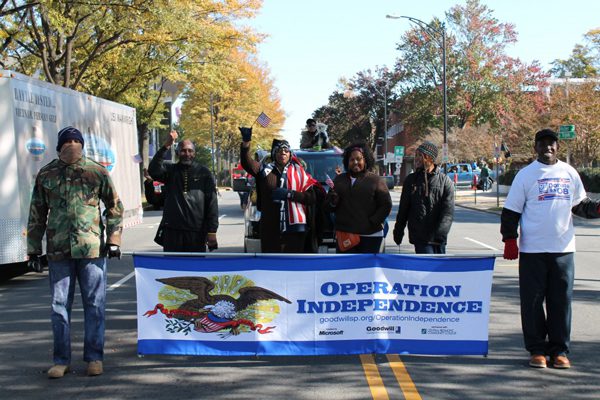Veterans in Mecklenburg: An infographic

Mecklenburg County is home to one of the largest veteran communities in North Carolina. As one of the Regional Indicators Partners, Goodwill Industries of the Southern Piedmont collaborates with the UNC Charlotte Urban Institute to monitor trends among veterans (and other populations Goodwill serves). The infographic below provides a snapshot of the 55,000 veterans living in the county.
Through its Operation Independence Program, Goodwill helps veterans and their families adjust to civilian life after serving in the armed forces. In partnership with Central Piedmont Community College, the Operation Independence Program “provides veterans and their families with a comprehensive set of services to help them transition to civilian careers, including technology skills training, job placement, career counseling, and other support services” (http://www.goodwillsp.org/services/operation-independence). The program has served more than 100 veterans and their families in the Charlotte area since it began in 2010 (GISP 2011 Annual Report).
Mecklenburg County’s veteran population is predominantly male and white. More than 90 percent of veterans are male, and more than 60 percent identify as non-Hispanic white.
Nearly all Mecklenburg veterans have completed at least a high school education. This would be unusual for just about any other group, but having a high school diploma or equivalent is a requirement to enlist in the armed services. However, only one-third of the county’s veterans have four-year college degrees, compared to more than 40 percent of non-veterans.
The unemployment rate for veterans in Mecklenburg County is slightly lower than non-veterans (9.4 percent vs 10.6 percent). As a group, veterans have higher incomes and lower poverty rates than non-veterans, in line with national trends. The income figures used here might seem lower than expected; that is because these figures represent personal income, not household income which is more commonly reported. Also important to note is that income includes not only wages, but also Social Security, retirement pensions, Veterans Affairs payments, other public assistance and many other forms of periodic income.
Interesting differences appear when dissecting income by gender. The distance between men’s and women’s incomes is greater among veterans than non-veterans. The difference between veteran and non-veteran incomes is larger for men than women.
Disabilities are more prevalent among veterans. This is not surprising, given that many have served in combat roles, but also because veterans, as a group, are older than non-veterans. More than one-third of veterans are over 65. (Click here to scroll to data notes and source information for the infographic)


Data Source: U.S. Census Bureau, 2011 American Community Survey 1-Year Estimates (Table S2101)
Unless otherwise noted, all statistics presented are for the civilian population 18 years and over and do not include children or individuals who are currently serving on active duty.
Veterans are defined as individuals who are at least 18 years of age and served for any period of time, but are not currently serving, on active duty in the U.S. Armed Forces.
The race and ethnicity statistics presented are limited to individuals of a single race. Hispanic or Latino is not considered a separate race but an ethnicity, so individuals identifying as Hispanic or Latino can be of any race.
Educational attainment figures are for the civilian population 25 years and over. High school graduate includes equivalency (GED).
Employment statistics are for the civilian population 18 to 64 years old. The labor force consists of people classified as employed or unemployed.
Median income numbers represent the personal income in the past 12 months. Income includes wages, Social Security, retirement pensions, Veterans Affairs payments, other public assistance, and other forms of income. Figures reported reflect 2011 inflation-adjusted dollars.
Poverty status is determined by the Census Bureau based on a number of factors including income, age, family size, and number of children in the family.
Individuals with a disability reported having one or more of the following difficulties: hearing, vision, cognitive, ambulatory, self-care, and independent living.
The categories under period of service are not necessarily mutually exclusive. Veterans may have served in more than one period and would be included in the numbers for each era they served.
Notes were derived from American Community Survey 2011 Subject Definitions.